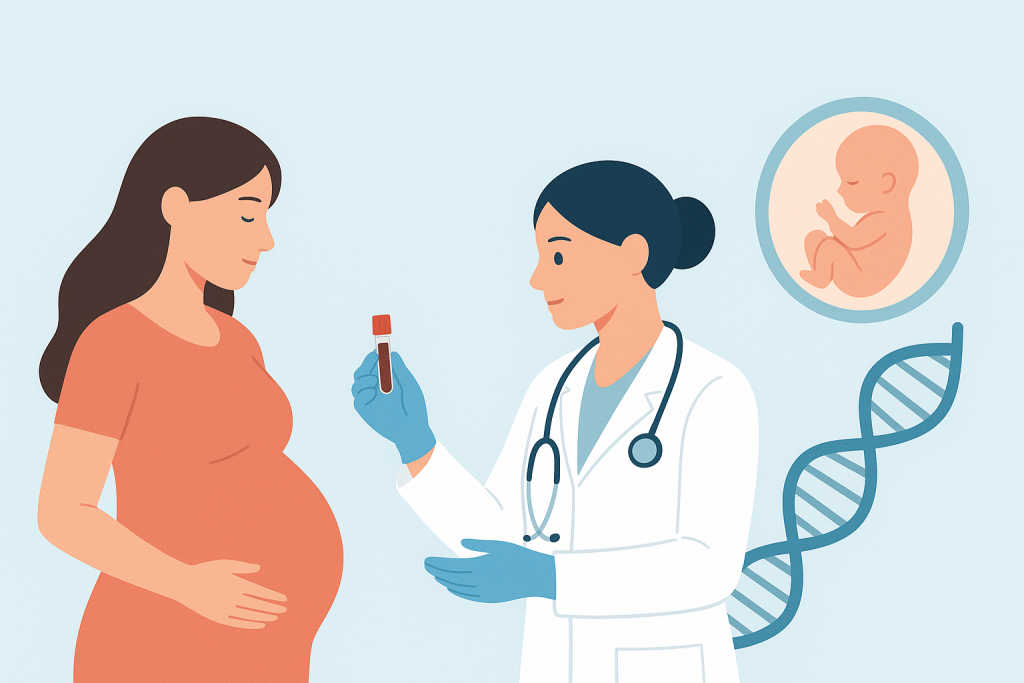Prenatal genetic tests are medical screenings conducted during pregnancy to detect conditions such as Down syndrome and cystic fibrosis. These tests give parents the chance to make informed decisions before birth, whether that means preparing for a child’s medical needs, making lifestyle adjustments, or deciding whether to continue the pregnancy. However, not everyone has access to such testing. In the United States, financial difficulties, lack of awareness, and breaks in education often prevent families from equal access to this testing. Therefore, while there are many costs and ethical questions, public funding for prenatal genetic testing would help promote fairness and informed decision making. By making this essential health information equally available, governments can ensure that all individuals are treated with respect and have equal opportunities.
Publicly funding prenatal genetic testing allows societies to promote fairness and equal access. If families are having to pay for prenatal testing out of pocket, access to vital medical information becomes a privilege rather than a right. Bunnik et al. (2020) in “Why NIPT Should Be Publicly Funded” states that a “two-tiered healthcare system” is created when NIPT (non-invasive prenatal testing) is offered only on a self-pay basis. In this, wealthier families can therefore afford personal reproductive information and easier decision-making, while lower income families are being excluded. 1
All pregnant individuals, regardless of income or background, deserve the right to make informed decisions about their pregnancies, and equitable access to prenatal testing then becomes a form of reproductive justice. According to Botkin (2016), families can plan for potential medical challenges from early on, if it is ensured that genetic testing and counseling are widely available. 2 Public funding would therefore help remove this cost barrier, and information that could significantly affect, help, and improve health outcomes and family well-being, can be accessible. In this way, public funding for prenatal testing becomes less about the technology itself, and becomes more about fairness in who gets to benefit from medical access.
Many critics argue that limited healthcare budgets must prioritize urgent, life-saving treatments instead of screening programs, such as these prenatal testing. However, one can use international models, particularly Canada’s, to understand that public funding for prenatal testing is both economically feasible and ethically sound. In Canada, prenatal genetic screening is a part of their public healthcare system and is offered with no separate, direct cost to patients; it is not considered less than urgent medical care and treatments, as it is in the United States. Programs such as Prenatal Screening Ontario and Perinatal Services BC provide testing for conditions like trisomy 21 (Down syndrome), trisomy 18, and neural tube defects to all pregnant individuals through provincial health plans. 3 4 This shared-cost model allows for universal access, as citizens contribute through taxes, without forcing families to pay up to $2000 out-of-pocket, as seen common in the U.S. 5
In contrast to the Canadian system, access to prenatal genetic testing in the United States is inconsistent and heavily dependent on insurance coverage, which also leads to confusion, hesitation, and limited support. For example, Medicaid, the primary form of public health insurance for low-income pregnant women, varies by state in the genetic tests that it covers. Some states fund NIPT for high-risk pregnancies, but some states do not cover it at all. This patchwork system leads to unequal access and leads to regional health disparities. Furthermore, unlike Canada’s coordinated national approach, the U.S. system often leaves patients having to navigate confusing insurance policies and processes, all still leading to unpredictable out-of-pocket costs.

The issue of inconsistent insurance coverage deepens inequality in access to prenatal genetic testing, as cost does present as the central barrier. In the United States, an individual receiving testing often depends on their type of health insurance, whether it be private or public, creating a fragmented and unfair system. Most private health insurance plans cover non-invasive prenatal testing (NIPT) and ultrasound screenings for some genetic and structural problems, but the coverage specifics vary a lot from one provider to the next. Many private insurance companies will only pay for NIPT if the pregnancy is considered “high-risk,” which can mean that the parent giving birth is over 35 years old or has a history of chromosomal problems. Medicaid, on the other hand, is very different from state to state. It helps millions of low-income pregnant people. Some state Medicaid programs only pay for the most basic prenatal tests, like routine blood tests or a standard 20-week anatomy ultrasound. These tests look for visible structural problems but not genetic or chromosomal problems. Some people may only pay for advanced screening when it is medically necessary or after the first signs of problems are found. 6
This variation suggests a troubling reality, that the kind of prenatal information parents receive does not depend on medical need, but rather on where they live and what insurance they have. For example, an expectant mother in a state with broad Medicaid coverage might have access to both NIPT and diagnostic follow-ups, while an expectant mother in another state may not be offered these tests, not even an ultrasound that could possibly detect anatomical defects or abnormalities. As wealthier, privately insured families receive earlier and more complete information, an inconsistent rise can be seen, undermining national health equity and creating a two-tiered standard of care.
In order to illustrate why universal access matters, it is important to understand what families actually do with these results. While one may think that parents use this genetic testing simply to make termination decisions, the truth is actually that many parents want to use these results to prepare emotionally, medically, and financially for a child with special needs. Results can guide decisions about birthing location, specialist referrals, and postnatal care plans, especially for conditions like congenital heart defects or spina bifida. This information can be denied or delayed due to patchy insurance coverage, and this limits not only parental autonomy, but also medical preparedness. When coverage is inconsistent, the burden of decision-making shifts from doctors and healthcare systems to the individuals that are navigating costs, uncertainty, and moral pressure on their own. Public funding would help close the gap between what technology makes possible and what insurance allows. This would align access with medical ethics and fairness, rather than financial privilege.
It can be seen that while a common objection to public funding of prenatal testing is financial, it can be addressed and prioritized if properly planned and implemented. The Canadian model illustrates that universal access to prenatal testing is possible when governments treat it as an essential health service rather than a luxury, which reinforces the idea that a lot of healthcare access and equity issues is about mindset and what is prioritized. It also challenges the assumption that public funding for such programs is financially unfeasible, as it is easy to question the U.S. government’s healthcare budget, to be in a place where it is not be able to allocate funds to inform parents of life-long or even fatal genetic disorders. The Canadian experience demonstrates that public investment in prenatal testing is not only possible, but it is a reflection of societal priorities. It gives parents the education, awareness, hope, and guidance to understand that informed reproductive health is beneficial.
Opponents of public funding for prenatal testing argue that widespread, government-supported genetic testing could pressure parents into screening, or even terminating pregnancies, based on results from these genetic tests. This raises fears amongst populations of promoting discriminatory attitudes toward people with disabilities, and possibly devaluing their lives. While these concerns are valid and should be addressed through ethical safeguards, precautions, and awareness, they should not be a reason for the denial of access. As de Jong and Dondorp (2010) argue in “Prenatal Screening: An Ethical Agenda for the Near Future”, the moral challenge of prenatal testing is not the testing itself, but how it is implemented. 7 Without strong counseling and informed consent guidance, even these voluntary testing can feel forced and scary.

Public funding, therefore, should come hand-in-hand with education and counseling services that would reemphasize that testing is an option, not an obligation. Studies have shown that when genetic counseling accompanies prenatal testing, parents are more confident in their decisions, and are less likely to feel pressured. 8 By funding both testing and counseling, governments can and ethically have a responsible and effective model to support autonomy, while still preventing misuse.
Going beyond ethics, public funding for prenatal genetic testing is also economically sensible, as early detection of genetic conditions can allow for better medical preparation and reduce the long-term costs of emergency interventions and unplanned care. Gekas et al. (2016) found that NIPT is cost-effective in Canada’s healthcare system because it decreases the need for invasive procedures such as amniocentesis done during pregnancy, which carries risks and requires extensive hospital resources. 9
The central question in this is not simply whether governments can afford to fund prenatal testing, but whether they can afford not to. Denying access to information based on income undermines reproductive autonomy and equality in societies. Publicly funded programs can respect both autonomy and ethics by empowering parents with information, education, guidance, and decision-making openings, while also ensuring counseling to prevent coercion or bias.
As Lo (2013) describes, noninvasive prenatal testing has transitioned from “dream to reality” in modern medicine, and its integration into equitable healthcare systems represents progress in both science and ethics. 10 The Nuffield Council on Bioethics (2017) emphasizes that the goal should not be to encourage or discourage testing. It is to make sure individuals have meaningful access to accurate information, support, and awareness of medical complications and possibilities. 11
In this way, public funding of prenatal genetic testing shows our shared responsibility. This is not to control people’s choices, but to give them the ability to choose.
Public funding for prenatal genetic testing is more than a policy issue; it is a reflection of the kind of society to aspire to be. When access to essential health information depends on income, it risks drowning in issues like inequality and lack of autonomy in our society. Investing in public funding will support medical progress and strengthen our commitment to health equality and inclusion. Political advocates, insurance companies, and healthcare systems together must work to can make prenatal testing universally accessible, without compromising ethics.

Ultimately, achieving equity in prenatal genetic testing requires collective commitment from policymakers, healthcare providers, and society. Public funding is not merely a financial or medical decision. It is a moral and civic effort, essentially reflecting a nation’s priorities and values. Governments would be able to uphold the ethical principles of justice and human dignity by ensuring that all families have access to essential health information, regardless of income or location. This issue also connects to broader conversations about health disparities and disability inclusion. When public health systems invest in both testing and counseling, they can not only empower parents with knowledge, but also create structures of support. This can lead to a prevention in coercion or misinformation. Moreover, equitable access to prenatal testing aligns with overall global health goals that also emphasize prevention and fairness. The issues explored, in expanding coverage, integrating education, and reinforcing ethics, moves societies closer to a compassionate model of healthcare, valuing both the freedom to choose and the responsibility to care.
- Eline M. Bunnik, Adriana Kater-Kuipers, Robert-Jan H. Galjaard, and Inez de Beaufort, “Why NIPT Should Be Publicly Funded,” Journal of Medical Ethics 46, no. 11 (2020): 783–784, https://doi.org/10.1136/medethics-2020-106062. ↵
- Jeffrey R. Botkin, “Ethical Issues in Prenatal Genetic Testing,” Seminars in Fetal and Neonatal Medicine 21, no. 2 (2016): 67–72, https://doi.org/10.1016/j.siny.2015.12.001. ↵
- Perinatal Services BC, Prenatal Genetic Screening in British Columbia: 2022 Program Overview (Vancouver: Provincial Health Services Authority, 2022), https://www.perinatalservicesbc.ca. ↵
- Prenatal Screening Ontario, Prenatal Screening for Chromosome Differences (Toronto: Ontario Ministry of Health, 2023), https://www.prenatalscreeningontario.ca. ↵
- ValuePenguin, “How Much Does Prenatal Testing Cost?” ValuePenguin by LendingTree, updated 2024, https://www.valuepenguin.com/cost-of-prenatal-testing. ↵
- Megan Allyse, Sara L. Minear, Marsha Michie, et al., “Non-Invasive Prenatal Testing: A Review of International Implementation and Challenges,” International Journal of Women’s Health 7 (2015): 113–126, https://doi.org/10.2147/IJWH.S67124. ↵
- Adriana de Jong and Wybo Dondorp, “Prenatal Screening: An Ethical Agenda for the Near Future,” Bioethics 29, no. 1 (2015): 46–55, https://doi.org/10.1111/bioe.12128. ↵
- Celine Lewis, Melissa Hill, and Lyn S. Chitty, “A Qualitative Study Looking at Informed Choice in the Context of Non-Invasive Prenatal Testing for Aneuploidy,” Prenatal Diagnosis 37, no. 13 (2017): 1221–1228, https://doi.org/10.1002/pd.5173. ↵
- Catherine Gekas, Claudia Langlois, France Ravitsky, and François Rousseau, “Cost-Effectiveness of Non-Invasive Prenatal Testing for Down Syndrome,” Canadian Medical Association Journal 188, no. 7 (2016): E164–E172, https://doi.org/10.1503/cmaj.150963. ↵
- Y. M. Dennis Lo, “Noninvasive Prenatal Diagnosis: From Dream to Reality,” Clinical Chemistry 61, no. 1 (2015): 32–37, https://doi.org/10.1373/clinchem.2014.223677. ↵
- Nuffield Council on Bioethics, Non-Invasive Prenatal Testing: Ethical Issues (London: Nuffield Council on Bioethics, 2017), https://www.nuffieldbioethics.org/publications/non-invasive-prenatal-testing. ↵



